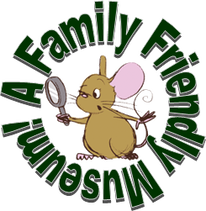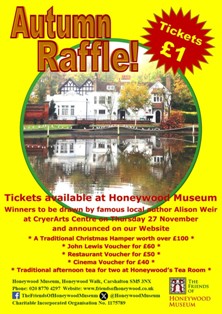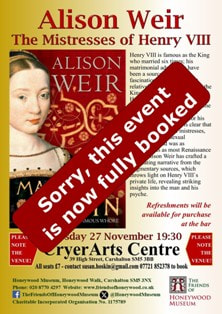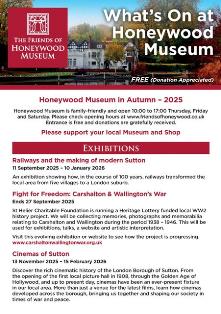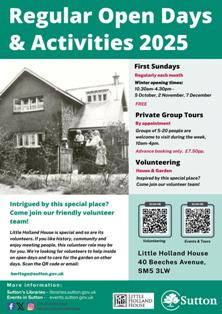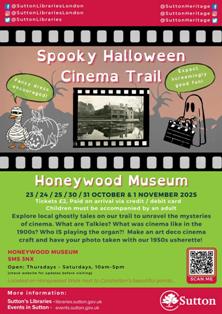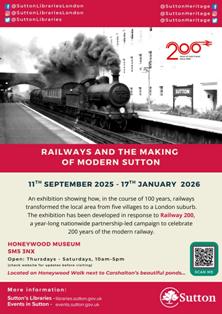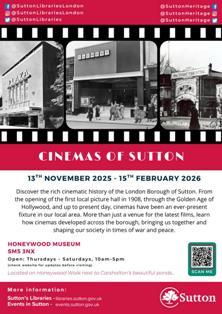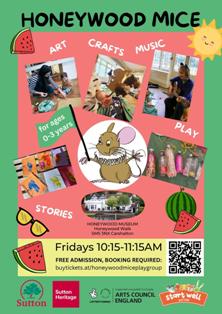Open Thursday to Saturday 10:00-17:00
Admission Free - Families Welcome
Honeywood Walk, Carshalton SM5 3NX
Telephone 020 8770 4297
Find Honeywood Museum
Admission Free - Families Welcome
Honeywood Walk, Carshalton SM5 3NX
Telephone 020 8770 4297
Find Honeywood Museum
About Honeywood Museum
Honeywood Museum is a Grade II listed building overlooking picturesque Carshalton Ponds in the heart of Carshalton's historic Conservation Area. Surrounded by historic buildings and water-features the locality forms one of the most interesting and attractive areas in Greater London. The Museum re-opened, after a complete refurbishment following a Heritage Lottery Fund grant, in May 2012 and has increasingly become a popular attraction renowned for its family-friendly welcome, and its wide range of activities and events for all ages. The building has a history that dates back to the mid-17th century, with Victorian and Edwardian extensions, including a fine Billiard Room, Drawing Room and Victorian Scullery. There are exhibitions which tell the fascinating history of the house and the people who lived there, and illustrate the history of the Borough of Sutton, the development of Carshalton from its entry as Aultone in the Doomsday Book to the thriving village it has become, and the historic environs of the River Wandle.
|
Honeywood is owned by the London Borough of Sutton and run by council staff assisted by volunteers supported by both the council and The Friends. The Friends are currently providing financial assistance to Sutton council with the ongoing maintenance and upkeep of the building and its grounds.
Visitors are welcome to take photographs, so long as it is done sensibly and with respect to other visitors. |
The Museum has an on-going diary of events, regular events and exhibitions which illuminate the history of many aspects of the Borough of Sutton, and a fascinating range of topics beyond. Families are warmly welcomed! Look out for the delightful collection of Edwardian toys on display in the Childhood Room and visit the lovely tea room and The Friends' Shop with its range of publications, greetings cards, pocket-money toys and unusual gifts. The Friends support all this, and very much more.
The Friends' next Events
We will be announcing the first of our 2026 Talks here in early December. Do look back, and please do book early: our talks are always popular and generally fully booked well in advance! Click / tap on the images below for booking details when the time comes, or download, print and post a booking form from HERE.
See our Events page for all the future Events at Honeywood Museum.
See our Events page for all the future Events at Honeywood Museum.
The Friends' Shop at Honeywood Museum
In our shop We have a variety of items on sale at affordable prices, including mugs, trinket boxes and storage caddies, coasters, tea towels, notebooks and notepads, glasses cases, soaps, and lots of greeting cards. We like to support the growing Carshalton community of artists, and stock cards and other items created by some of them, including coasters, book marks and magnets featuring our local pubs and landscapes. And we have a range of books, leaflets and maps relating to local history, many written by local authors. Our shop is open throughout the Museum's opening times. Shop local and support us! We take both cash and cards.
What's On at Honeywood MuseumThe Autumn edition of What's On is now available at Honeywood. As always, it's FREE. A small voluntary donation to help us cover our production costs is always appreciated.
Exhibitions and Events, and family-friendly occasions during September, October and November are included. Pick up your copy - make notes in your diaries and calendars. Read the whole issue, download it or print it from HERE. |
The Tea Room at Honeywood MuseumThe Tea Room is open Monday to Wednesday from 10:15 to 15:45 and Thursday to Sunday from 10:15 to 16:45, serving its tempting menu of tasty savoury treats and their luscious home-made cakes.
When Honeywood Museum is closed our ever-popular Duck Food and our Carshalton Heritage Walk booklet (both 50p) will be available from the Tea Room - a natural food for our resident water fowl, and an exploration of lovely Carshalton to wander whilst discovering its historic past! |
Little Holland HouseOpen Days at Little Holland House for 2025.
A remarkable self-built Arts & Crafts treasure near Carshalton Beeches station that is well worth a visit. Find out more here. |


